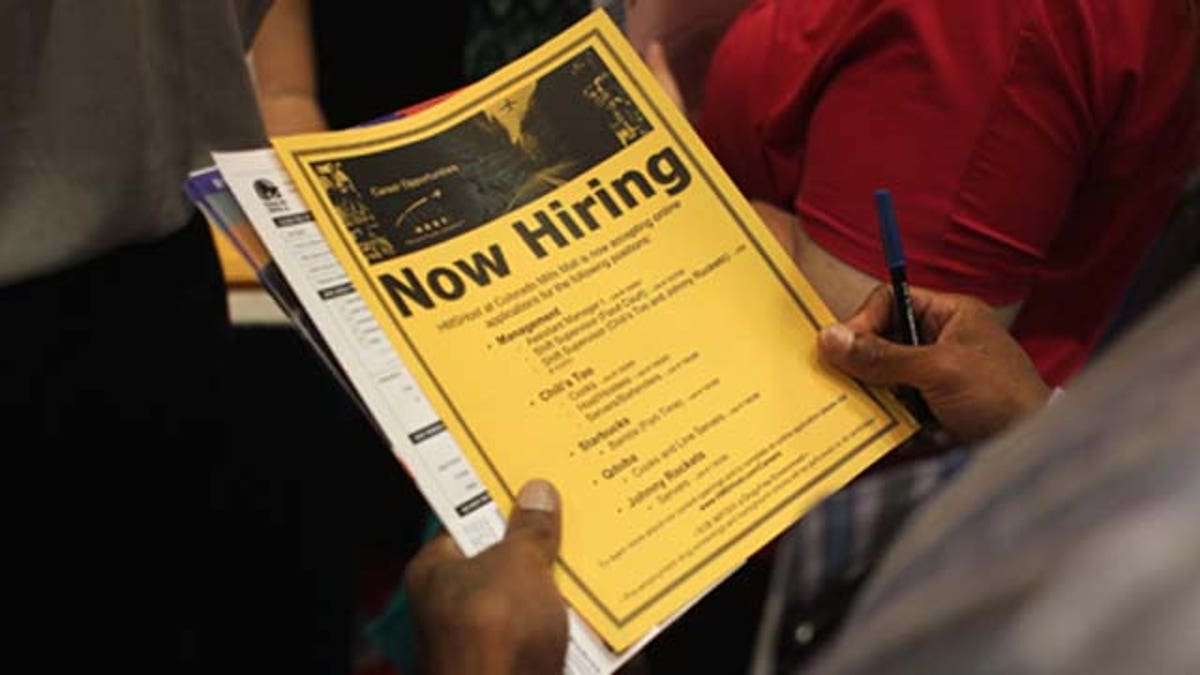
Sept. 9, 2010: A job seeker reads a flier at a state-sponsored job fair on September 9, 2010 in Denver, Colorado. (2010 Getty Images)
Fewer people applied for unemployment stipends last week, the Labor Department said on Thursday.
The submissions, however, are not necessarily an indicator that the job market is progressing.
Weekly applications decreased by 9,000 to a seasonally adjusted 423,000, the department said.
The four-week average, a less volatile figure, rose slightly for the fifth straight week to 421,000.
Applications typically need to fall below 375,000 to signal sustainable job growth. They haven't been that low since February.
"September is shaping up to be another difficult month for the job market," said Ryan Sweet, an economist at Moody's Analytics.
Higher unemployment benefit applications may suggest more employers are laying off workers amid growing worries that the economy has weakened.
Pacific Biosciences of California Inc. said Wednesday that it will cut 130 employees, or 28 percent of its work force. Last week, Bank of America Corp. said it is cutting 30,000 jobs.
Still, economists say the main problem is that there are few jobs for the 14 million people who are unemployed.
The economy will probably see some job growth in September after none in August, Sweet said. But the net gains will mostly come from roughly 45,000 Verizon workers who are back on the job after an August strike.
"Outside of that, it seems that hiring has been kept to a minimum," Sweet said.
Many businesses pulled back on hiring this spring after seeing demand for their products drop. Consumers have had less money to spend on discretionary goods because they are paying higher prices for gas and food, while seeing meager pay raises. That has taken a toll on the economy because consumer spending fuels 70 percent of growth.
In the first half of the year, the economy expanded at an annual rate of just 0.7 percent. In August, employers added no net jobs, and consumers didn't increase their spending on retail goods.
The unemployment rate has been above 9 percent in all but two months since the recession officially ended more than two years ago. Last month it was 9.1 percent.
Most economists expect the economy will grow no more than 2 percent for the year. That's barely enough to keep up with population growth, and far below the 5 percent rate that most economists say is needed to bring down the unemployment rate.
The number of people receiving unemployment benefits fell for the third time in four weeks, to 3.73 million. But that doesn't include more than 3 million people receiving extended benefits under emergency programs set up by Congress during the recession.
All told, about 6.9 million people received unemployment aid in the week ending Sept. 3, the latest data available. That's down about 250,000 from the previous week.
Such weakness has raised pressure on President Barack Obama and the Federal Reserve to boost economic growth.
On Wednesday, the Fed said it will try to push long-term interest rates lower and make consumer and business loans cheaper by shifting $400 billion out of short-term Treasury securities and into longer-term bonds.
The central bank said it will also reinvest the proceeds from its maturing mortgage-backed securities into new mortgage-backed bonds. That should reduce mortgage rates.
President Barack Obama, meanwhile, has proposed a $447 billion job-creation package. He wants to cut Social Security taxes for workers, extend unemployment benefits, cut taxes for small businesses and spend more federal money to build roads, bridges and other public works projects.
But the president's proposal faces opposition in Congress. Republicans object to his proposal to pay for the plan with higher taxes on wealthier households, hedge fund managers and oil companies.
Based on reporting by the Associated Press.
Follow us on twitter.com/foxnewslatino
Like us at facebook.com/foxnewslatino
